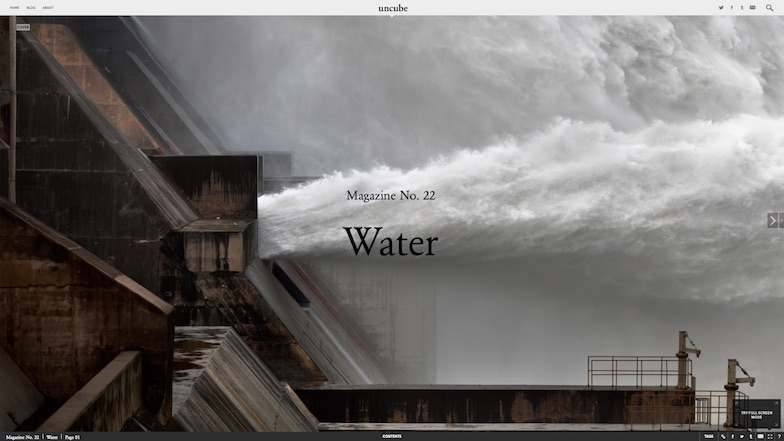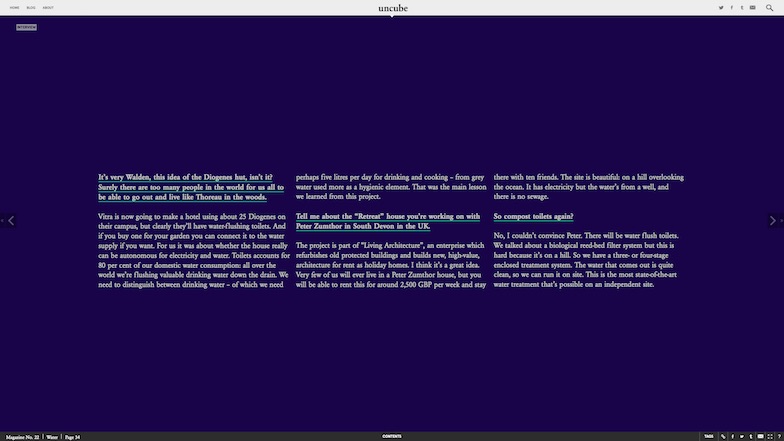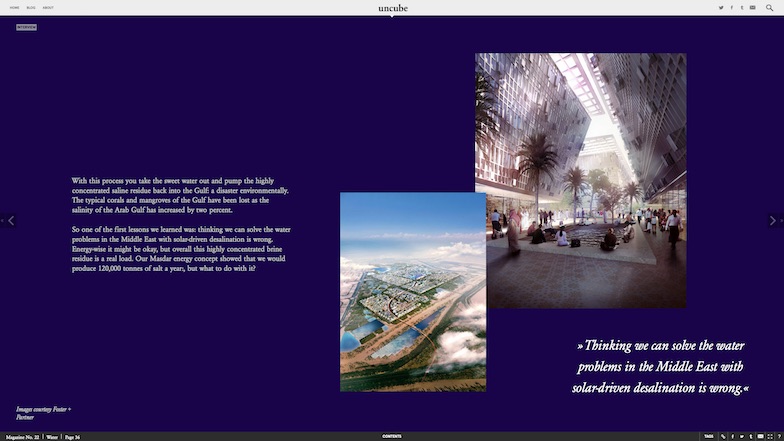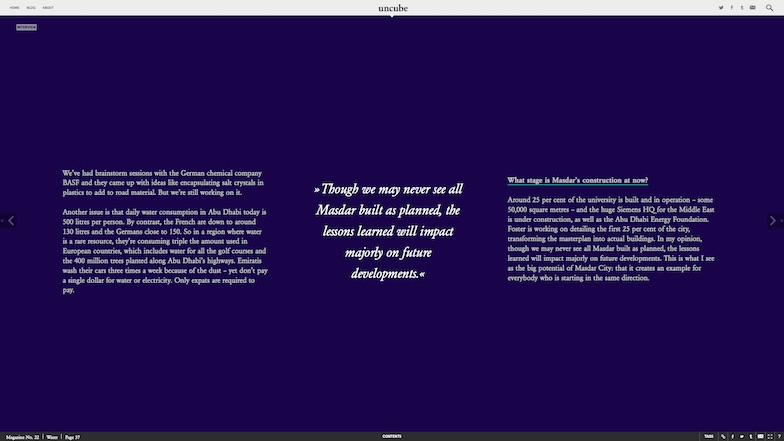Matthias Schuler is the founder of one of the world’s leading climate engineering firms, Transsolar, and teaches at Harvard Graduate School of Design. He has worked with Frank Gehry, OMA, Herzog de Meuron, Stephen Holl, Jean Nouvel, Norman Foster and many others developing sustainable design strategies for everything from cabins to entire cities. He talked to uncube about thermodynamic entities, compost toilets and the measures we need to take if we are going to survive the next flood.
(Read original article online)
You call yourself a “climate engineer”. What does that mean exactly?
As engineers and physicists, we understand buildings and cities as thermodynamic systems. We want to understand how they perform – not mechanically, but in their reaction to outside loads, such as wind and sun exposure. Energy, air quality and resources such as water, are our focus and we seek to optimise performance by adapting forms and openings through “passive measures” – the building itself should do as much as possible. It’s important to be part of the design team from the start, so architects can integrate these measures, tailored to each individual building and its site: what we call local thermodynamic identity.
Talking of specific projects, you completed a tiny and self-sufficient building prototype recently with Renzo Piano for Vitra, called “Diogene”.
The main intention of that building was to show people you can live on a small footprint, not just spatially but energy and material-wise as well. This project was Renzo’s life dream; he first sketched it as a student and has worked on it throughout his career. Now finally he found Vitra to support it and even develop a product out of it. It’s not intended to be a permanent home, more a weekend place or maybe an extension to an existing building. The idea is you could place it wherever you want, unconnected to any form of civilisation, to any grid. No electricity, no water, no sewage, nothing. It will have limited capacity for energy generation, water collection and storage, so at some point, you may have to decide between a hot shower or warm food. Therefore it was obvious it should do without a water toilet. This provoked one of the longest discussions with Renzo! He’s a sailor, and said: “you really have to love someone on a boat to share a chemical toilet”. That was his experience of the non-water flush toilet. But I told him we could use a compost toilet. We even installed one in the office which the whole company used for two months – with no smell problem! The important thing with compost toilets is to separate the urine and faeces. When mixed, a digestion process starts, which creates the smell. If you separate them, it just dries off. Urine is a great fertiliser so you can use it for your tomatoes around your Diogene. The solid matter is collected in a self-composting bag which, when full, can be taken out, buried, and takes about a year to turn into soil.
It’s very Walden, this idea of the Diogenes hut, isn’t it? Surely there are too many people in the world for us all to be able to go out and live like Thoreau in the woods.
Vitra is now going to make a hotel using about 25 Diogenes on their campus, but clearly, they’ll have water-flushing toilets. And if you buy one for your garden you can connect it to the water supply if you want. For us, it was about if the house really can be autonomous for electricity and water. The toilet accounts for 80 per cent of our domestic water consumption: all over the world, we’re flushing valuable drinking water down the drain. We need to distinguish between drinking water – of which we need perhaps five litres per day for drinking and cooking – from greywater used more as a hygienic element. That was the main lesson we learned from this project.
Tell me about the “Secular Retreat” house you’re working on with Peter Zumthor in South Devon in the UK.
The project is part of the “Living Architecture” there, an enterprise where they both refurbish old protected buildings and build new, high-value, architecture, for rent as holiday homes. I think it’s a great idea. Very few of us will ever live in a Peter Zumthor house, but you will be able to rent this for around 2,500 GBP per week and stay there with ten friends. The site is beautiful: on a hill overlooking the ocean. It has electricity but the water’s from a well, and there is no sewage.
So compost toilets again?
No, I couldn’t convince Peter. There will be water flush toilets. We talked about a biological reed-bed filter system but this is hard because it’s on a hill. So we have a three- or four-stage enclosed treatment system. The water that comes out is quite clean, so we can run it on site. This is the most state-of-the-art water treatment that’s possible on an independent site.
That’s interesting because one doesn’t usually associate Zumthor buildings – or retreats – with high tech or “state-of-the-art”.
You’re right: I can imagine such a building by Zumthor with just water and no electricity, nothing else. But if you rent something for that amount, even if it’s a Peter Zumthor house, people still expect WiFi.
Turning to the other end of the scale, you did the climate concept for Norman Foster’s Masdar City masterplan in Abu Dhabi due to be six square kilometres in size.
The energy and climate concept for Masdar is one thing, but the water concept is also interesting. When we were approached to develop this carbon-neutral city with Foster, we had to include water treatment because there’s no fresh water in Abu Dhabi. The only water available is from the shallow Arab Gulf, which is 30 per cent more saline than the normal ocean. For the past 20 years, local states like Qatar and the UAE have all been surviving on desalinated water. With this process you take the sweet water out and pump the highly concentrated saline residue back into the Gulf: a disaster environmentally. The typical corals and mangroves of the Gulf have been lost as the salinity of the Arab Gulf has increased by two per cent. So one of the first lessons we learned was: thinking we can solve the water problems in the Middle East with solar-driven desalination is wrong. Energy-wise it might be okay, but overall this highly concentrated brine residue is a real load. Our Masdar energy concept showed that we would produce 120,000 tonnes of salt a year:, but what to do with it? We’ve had brainstorm sessions with the German chemical company BASF and they came up with ideas like encapsulating salt crystals in plastics to add to road material. But we’re still working on it. Another issue is that daily water consumption in Abu Dhabi today is 500 litres per person. By contrast, the French are down to around 130 litres and the Germans close to 150. So in a region where water is a rare resource, they’re consuming triple the amount used in European countries, which includes water for all the golf courses and the 400 million trees planted along Abu Dhabi’s highways. Emiratis wash their cars three times a week because of the dust – yet don’t pay a single dollar for water or electricity. Only ex-pats are required to pay.
What stage is Masdar’s construction at now?
Around 25 per cent of the university is built and in operation – some 50,000 square metres – and the huge Siemens HQ for the Middle East is under construction, as well as the Abu Dhabi Energy Foundation. Foster is working on detailing the first 25 per cent of the city, transforming the master plan into actual buildings. In my opinion, though we may never see all Masdar built as planned, the lessons learned will impact majorly on future developments. This is what I see as the big potential of Masdar City: that it creates an example for everybody who is starting in the same direction.
Masdar, as well as your new Al Fayah Park project with Heatherwick Studios, are environments created from scratch in extreme conditions. What about interventions within existing buildings and cities? Should we knock down old inefficient structures and start again?
No, around 75 per cent of the embedded energy of a building is in its structure. So whilst you can replace its façade or technical systems, holistically, energy-wise it would be a crime to tear it down and build anew. A rough rule of thumb is that even for very low-energy buildings, it’ll take around 15-20 years to make up for the energy wasted in destroying the old one.
This leads us to the recent news of the Thwaite ice sheet’s collapse in Antarctica with sea levels now predicted to rise by up to ten feet over the next two centuries. If these predictions are true, massive changes are coming.
We’ve known this since at least 1972. At the time of the Club of Rome, they were already showing the limits of growth. The only thing we can do is change our social systems. Take the ETH Zurich 2000-Watt Society proposal for getting annual carbon emissions per person down to one tonne. This is exactly the kind of proposal to show the world – that it’s possible to do this yet keep a high-quality lifestyle. We must rethink our idea of luxury, asking ourselves: do we really need three TVs, walk-in refrigerators or whatever. Realistically, we can’t now save the world from some changes. There are already areas with annual temperature rises close to 2.5 degrees Celsius. Instead, we need our systems to be adaptive. This doesn’t mean everybody going and living in secular retreats without electricity or running water, but we do each need to live on a smaller footprint.
(From uncube magazine issue no. 22: “Water”, edited by Sophie Lovell)










